Please Take Note: This is a review of the final game, but it might change slightly based on the success of the Kickstarter campaign. The game is being reviewed on the components and the rules provided with the understanding that “what you see is not what you might get” when the game is published. If you like what you read and want to learn more, we encourage you to visit the game publisher’s website or visit the Kickstarter campaign. Now that we have all that disclaimer junk out of the way, on with the review.

The Basics:
- For ages 7 and up (publisher suggests 8+)
- For 2 to 7 players
- Approximately 25 minutes to complete
Geek Skills:
- Active Listening & Communication
- Counting & Math
- Logical & Critical Decision Making
- Pattern/Color Matching
- Strategy & Tactics
- Visuospatial Skills
- Semi-Cooperative Play
- Hand/Resource Management
Learning Curve:
- Child – Easy
- Adult – Easy
Theme & Narrative:
- Cooperatively build the perfect city with two semi-cooperative partners
Endorsements:
- Gamer Geek approved!
- Parent Geek approved!
- Child Geek approved!
Overview
American businessman James E. Casey said, “One measure of your success will be the degree to which you build up others who work with you. While building up others, you will build up yourself.” Mr. Casey’s statement holds true within the context of this game. You must cooperatively build a city with a partner on your left and on your right. But don’t be too generous. While this game does require cooperation, only 1 player can be the winner.
Between Two Cities, designed by Matthew O’Malley, Ben Rosset, and to be published by Stonemaier Games, will reportedly be comprised of 108 Building tiles (squares), 24 Duplex tiles (rectangles), 14 City tokens, 1 Scoreboard, and 7 Reference tiles. As this is a review of a prepublished game, I will not comment on the game component quality. What little artwork there is, by Beth Sobel, focuses on detailing the various buildings the players will be using to create the cities. The illustrations are not particularly eye-catching, but they do work very well within the game’s theme and allow the player to quickly scan their city area for patterns. This is mostly done through color, but each depicted structure is differently shaped, allowing those who have difficulty distinguishing color an easy means to see the same patterns as their fellow players.
Preplanning Set Up
To set up the game, first seat the players so there is an even space between all of them. I know this sounds like a silly step, because “duh”, but this space between players is very important to the game play. During the game, a player will be working on building a city on their left and on their right, cooperating with their partner/opponent. As such, players won’t be playing to the middle of the playing area.
Second, place the Scoreboard in the middle of the playing area and within each reach of at least 1 player.
Third, place 1 City token in the general area between each player. This token indicates where the city will be built. Then place the matching City token next to the Scoreboard. This City token will be used to keep track of the city score. Place any City tokens not used back in the game box.
Fourth, shuffle the Duplex tiles (the rectangular ones) and place them face-down in several stacks next to the Scoreboard. Place the Building tiles face-down in the top of the game box and randomize them. Place this box top in the middle of the playing area next to the Scoreboard and the Duplex tile stacks.
This completes game set up. Hand each player a Reference tile, determine who will be the first player, and begin building your cities!
Semi-Cooperative City Construction
Between Two Cities is played in rounds for a total of 3 rounds in a single game. There are no player turns, meaning players complete and resolve steps during the round at the same time. All 3 rounds are structured the same, but the individual challenges a player will face will be very different. A typical game is summarized here.
Round One
Step 1: Draw Tiles
Each player draws a hand of 7 Building tiles (the square ones) and keeps them hidden while they review them.
Step 2: Select Tiles
When the player is ready, they select 2 of the tiles and place them face-down in front of them. The remaining tiles are placed face-down in a stack above the city building area to the player’s left. The City token for this city building area is then placed on top of the stack of tiles indicating the player is done selecting the tiles they want to keep.
Step 3: Reveal Selected Tiles
At the same time, and only after all the players have completed step 2, the selected tiles are revealed. This is done by simply flipping the tiles over that are in front of the player.
Step 4: Place Tiles to City Building Area
Now comes the fun part. The player works with the partner/opponent to their left and right to place their tiles to the city building area. Players are encouraged to discuss strategies and plan with their partner/opponent as much or as little as they like. Ultimately, it’s up to the player to decide where to place the tile. They do not have to listen to the input from their partner/opponent if they don’t want to, but that will end up hurting them in the long run. This is, after all, a game about cooperative city building. The only real restriction when it comes to conversing with the players to the left and right is hinting at or suggesting what tiles may or may not be in the face-down stacks or in the player’s hand before the tiles are revealed.
When placing a tile, there are only a few rules that must be followed:
- Only 1 tile from the 2 selected can be placed to a city building area. Which tile is placed is up to the player.
- A city building area cannot be any larger or smaller than what would fit in a 4×4 grid area. In other words, 4 Building tiles across and 4 Building tiles down to form a perfect square.
- All tiles must be orientated so the top of the tile is closest to the middle of the playing area.
- Every tile (except the first one) must be adjacent to another tile. Diagonal placement is not allowed. Shame on you for even suggesting it.
Step 5: Repeat
After the tiles have been placed, the player takes the stack of Building tiles on their right that have a City token on top. The players once again select 2 tiles to keep and place the remaining tiles in a face-down stack to their left. These newly selected tiles are placed to the city building area in the same way the last ones where. This continues for as long as there are tiles available in the face-down stack. When only 1 tile is left, it’s discarded to the middle of the game playing area. Do not put it back in the box.
This completes the first round of game play.
Round Two
Round two is played almost identical to round one, with only a few minor changes.
Draw 3 Duplex tiles instead of 7 Building tiles. Players select 2 of the 3 tiles and place them face-down in front of them. When everyone is ready, the 2 selected Duplex tiles are revealed and played to the city building areas.
Duplex tiles are essentially 2 Building tiles stuck together. They must be added to the city building area following the same rules as those noted in round 1, but only one of the two illustrated buildings need to adjacent to an existing tile in order to be placed. Put another way, you do not need to place the Duplex tile so it’s adjacent on all sides along the long edge. You can if you want to, but it’s not necessary. Duplex tiles come in two different varieties. Horizontal and vertical. Players should keep in mind that they will only be playing 1 tile to their cities this round, but each tile takes 2 spaces in their grid!
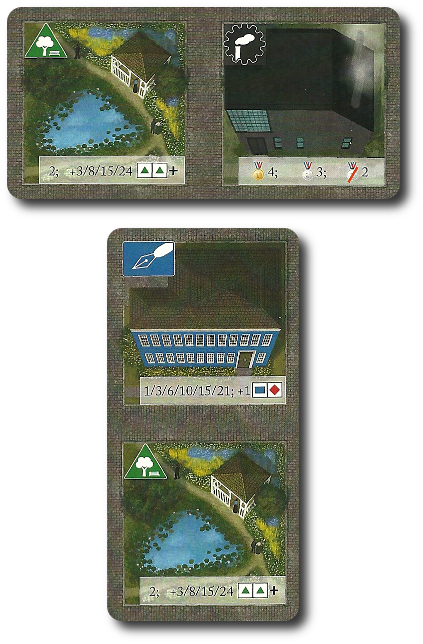
The remaining Duplex tile is then discarded to the middle of the playing area. This completes the second round of game play.
Round Three
Round three is round one in reverse. Players draw 7 Building tile and select 2 to play. However, the stack of Building tiles not used are passed to the player’s right this time (not to the left). This also means that players will be picking up tiles from the left, not from their right. This really shouldn’t throw anyone off, as the game mechanic is the same. Although, based on our observations of the game play, do expect a number of players to remark “how different” the game is during the third round.
It’s not.
Just like the first round, the last tile is discarded to the middle of the playing area. This completes the third round of game play. If the players were doing it correctly, there should be a city building area between every player that now depicts a tidy 4×4 city grid area (for a total of 16 structures).
Scoring
After the third and final round, it’s time to calculate city scores.
First, remove any discarded tiles from the Scoreboard and middle of the playing area. We need this clear to keep track of the points players have earned.
Second, assign one player to request and record scores from the different city building areas. This is done by calling out the building types found on the Reference tiles. Players who share a city building area should work together to quickly calculate and report the score. The score is kept track of by moving the matching colored City token on the Scoreboard.
The different structure types and how they score are summarized here. Regardless if the structure types are on a Building tile or Duplex tile, the scoring is the same.
Shops
Shops score points for every adjacent shop in a column or a row. A single Shop will bag the player 2 points, but having 4 Shops in a row (or column) will earn the player 16 points!

Factories
Factories are essential to create goods and to the city’s economic power. The city building area with the most Factories scores 4 points per Factory, with the city building areas with the second highest number scoring 3 per Factory. All other city building areas only score 2 points per Factory. Boooo…..
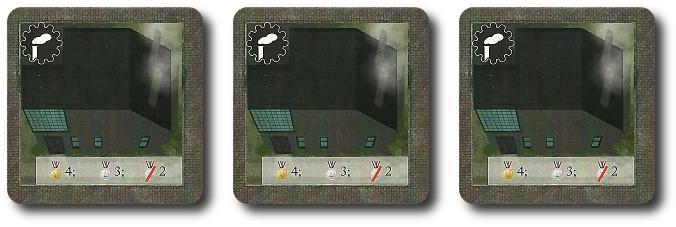
Taverns
Taverns offer travelers and patrons a well earned rest and opportunity to eat good food. But no one wants to eat and drink at the same place all the time. There are 4 different types of Taverns, each specializing in a different type of hospitality. Specifically, drink, food, rest, and what might be karaoke. We aren’t sure. What is for certain is that players will only score 1 point if they have the same Tavern, but having 2 different Taverns scores 4, 3 different Taverns scores 9, and having all 4 different types nets the player a big score of 17 points. Making Taverns even more enticing is that each set of Tavern tiles is scored separately, but each individual Tavern can only be used in a set once.

Offices
While the weekends are dedicated to yard work and play, the weekdays are all about paper work and getting paid. The more Offices the city building area has, the more points the Office earns. One Office is worth 1 point, but having 6 offices brings in 21 points! Having 7 or more Offices is super good, but the seventh Office starts the scoring at 1 again, but the points are added all together making for a big score.
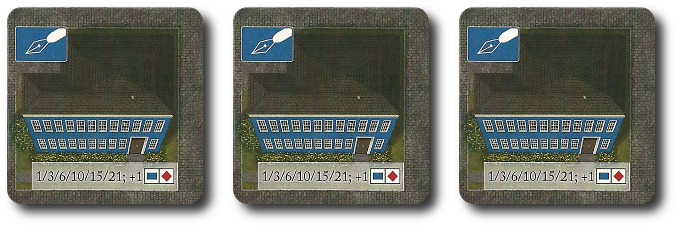
As an additional bonus, any Office that is adjacent to a Tavern gets a +1 to its score! Yeah! Happy Hour!
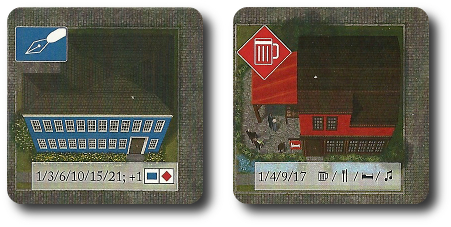
Parks
What city would be complete without a park or two? Each individual Park will score 2 points, but you can do better than that. Two or more Parks that are adjacent to each other are referred to as a “cluster”. The first Park cluster will score +3 points, the second Park cluster will score +8, the third Park cluster will score +15, and the fourth Park cluster will score +24 points. Keep in mind that the Park cluster scores are in addition to the Park itself. This means 2 Parks that are adjacent form a cluster and are worth 7 points (2 points per Park and +3 for the Park cluster). The only restriction is that each Park cluster must be kept separate if they are to be counted.
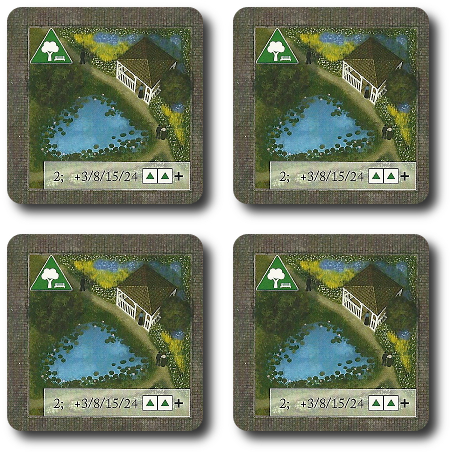
Houses
People will move to the city if there are wide variety of things to do and spend their money on. Each House is worth zero points by default. For every different structure type (not total number of structure types) the city has, each House is worth +1 point. For example, if the city building area had Factories, Offices, and Parks, each House would be worth 3 points.
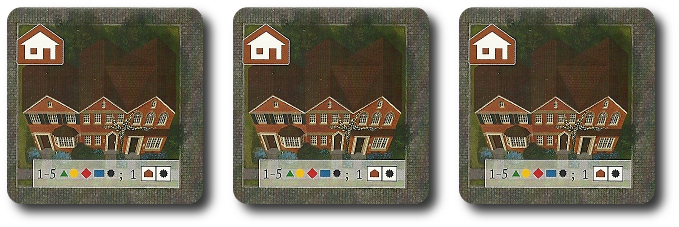
After all the points have been calculated and added together, the players determine which of the 2 city building areas scored the least amount of points. This is the player’s score for the game. Out of all the lowest scores earned, the player with the highest score wins!
Gamer Variant
Two-Player Game
Normally, a game of Building Two Cities requires at least 3 players, but this game variant allows you to enjoy the challenge of building the perfect city with a friend. Players sit opposite of each other and use the space to their left and right as their city building area. The cooperative element is removed and each player will be attempting to take the best tiles they can and give as few back to their opponent as possible. A total of 4 city building areas will be in play during the game, with the players working on the city building areas directly to their left and right only. Players will draw and pass tiles as normal, but with a few rule changes to keep the two-player game in balance. Scores are calculated in the same way as a 3+ player game, with the player with the highest lowest score winning.
To learn more about Between Two Cities, visit the game publisher’s website or visit the Kickstarter campaign.
Final Word
The Child Geeks focused a bit too much on placement of the tiles they had at the moment instead of thinking about the tiles to come. To a point where they debated where to put the two files they had during the round past the 5 minute mark. Their lack of long-term city planning was very apparent when it came time to score points, too. Their cities were always built somewhat haphazardly, but intelligently enough to score their builders points. According to one Child Geek, “I think it’s strange I am a partner with someone I am also trying to beat. But that’s kind of fun, too.” Watching the Child Geeks learn to “trust” the other players to their left and right was interesting. They knew they had to work together, but they also knew they were not working fully as a team. Another Child Geek said, “This is a neat game. It reminds me of 7 Wonders and Alhambra.” Yes, there are aspects of both games found in Between Two Cities, and both were used well. When all the games were over, the Child Geeks voted to approve Between Two Cities, finding it to be a fun game of semi-cooperative city building.
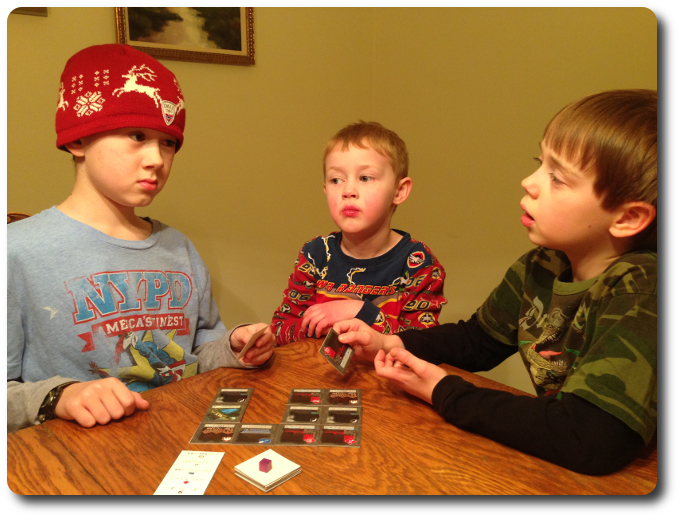
My two oldest debate where to put their tiles, while their younger brother wonders what all the fuss is about…
The Parent Geeks were also amused by the game. They very much enjoyed the simultaneous tile selection and the real-time game play as they discussed the best way to build the two cities. One Parent Geek said, “This game feels familiar, but I know I’ve never played a game like this. This is a lot of fun.” And fast, too. The Parent Geek really liked that aspect of the game. It was on the table just long enough to keep everyone engaged and entertained without feeling like it was dragging on. Another Parent Geek said, “This is really challenging, but it doesn’t feel difficult. You always have 2 tiles to work with, but you have to decide which of the two cities you will use them on. None of these tiles are bad, but part of the fun is deciding which tile should go where.” All the Parent Geeks voted to approve the game, finding it to be a perfect mix of difficulty and semi-cooperative game play for friends and family.
The Gamer Geeks found Between Two Cities to be a lighter game than what they would normally play for an evening, but quickly warmed up to it. One Gamer Geek said, “The way in which you have to build the cities with your opponents or partners or semi-partners – whatever we call them – is very interesting. I don’t know if they are holding back and banking on the other city or they are waiting for me to step up. That’s pretty cool.” Another Gamer Geek said, “My favorite part of the game is the end, and I don’t mean that in a negative way. The entire goal is to build the second best city, because you know the best will be removed from final scoring. This kept me thinking the entire time and calculating and recalculating my points in hopes that my second best was always going to be the big winner.” All the Gamer Geeks voted to approve Between Two Cities. They thought the scoring was a bit wonky at times, but nothing that slowed the game down.
I like to think of Between Two Cities as a game on two levels. The first is the simultaneous drafting of tiles and working on placing them to a city building area. This is not that difficulty because you know exactly what tiles you have available to you and what will give your city the most points in the end. The second level, and much more difficult aspect of the game in my opinion, is working with the other players. Everyone is focused on 2 cities which are in competition with each other and the cities around them. What I liked the most and found the most perplexing at times is that I never owned anything in the game, but I contributed to all of it. I added to the city building areas directly on my left and right. Through the tiles I selected and passed, I influenced the city building areas down the line. When you stop and consider it, I was essentially building every city in the game.
The game saves the player from thinking too hard about all this, however, since it always demands the focus be brought back to the two cities the player has direct influence over. Players will need to “calculate and re-calculate” scores, as one of our players said, but not to a point where they becoming living calculators. A quick scan of the city building area will let a player know where they are approximately at. The more familiar a player becomes with the game, the easier this exercise is. But make no mistake, players need to get comfortable with glancing at the city building areas around the table to understand what they should be focusing on. This is not a game about making as many points as possible. This is a game about controlled growth, and by extension, controlled points.
This is a well-paced game with deep play, strategy, tactics, and negotiation with semi-cooperative player interaction. It plays very well with small or large groups, entertained us all, and made us rethinking our future plans to build real cities with our friends and relatives. If you enjoy simultaneous selection, tile building, and semi-cooperative games, do sit down and play Between Two Cities.
This is a paid for review of the game’s final prototype. Although our time and focus was financially compensated, our words are our own. We’d need at least 10 million dollars before we started saying what other people wanted. Such is the statuesque and legendary integrity of Father Geek which cannot be bought except by those who own their own private islands and small countries.



